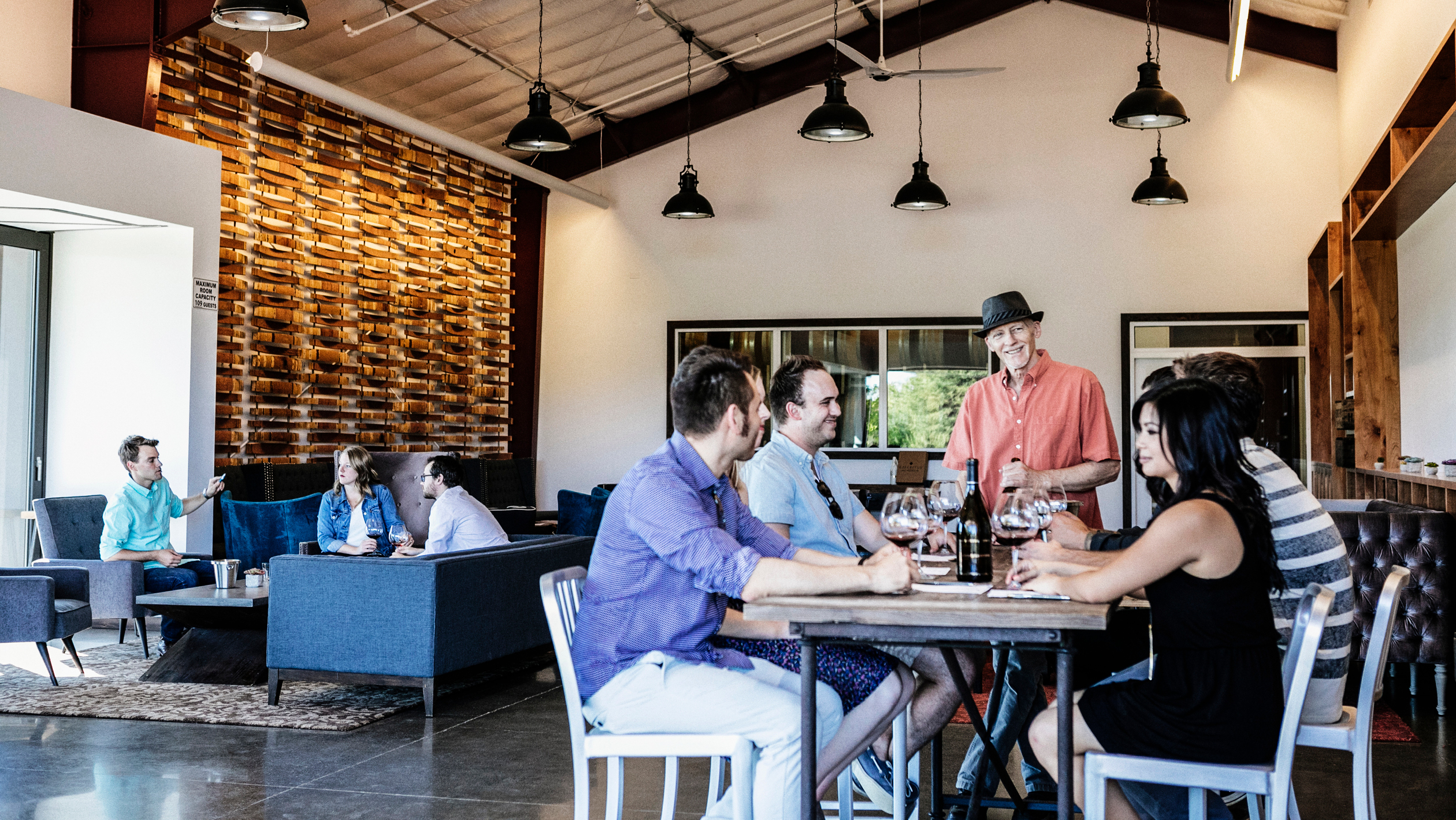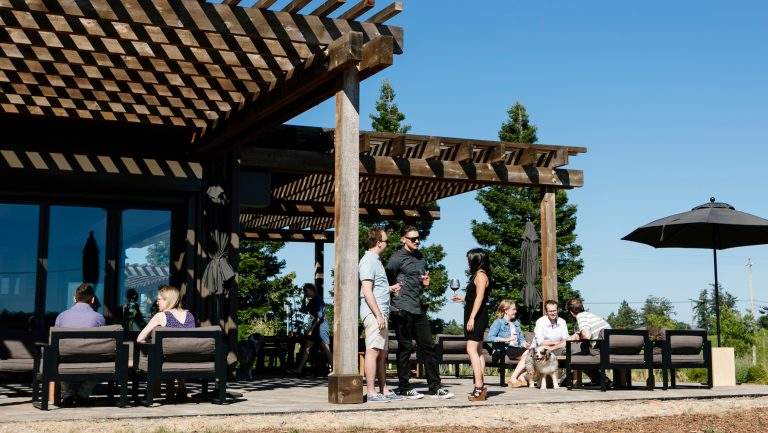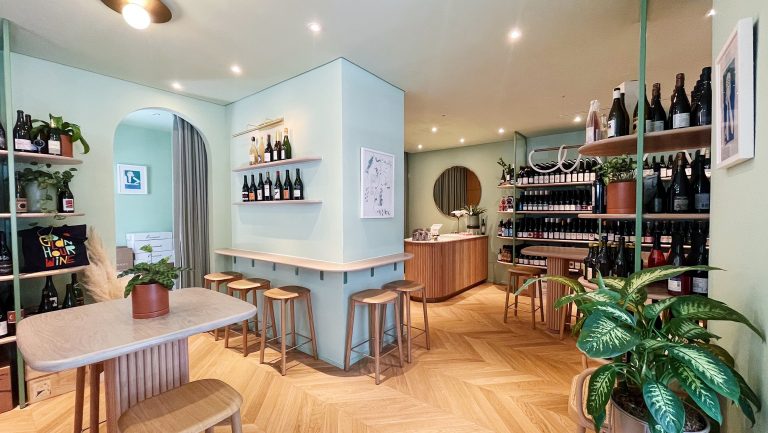Walking into the Emeritus tasting room is like walking into an elegantly appointed living room.
Set in a rustic tin barn on the Hallberg Ranch Estate in Sebastopol, the space is broken up by a series of small, cozy seating arrangements both inside and outside on the terrace. Large floor-to-ceiling windows offer idyllic views of the estate’s Pinot Noir vineyards, and the folding glass wall system by NanaWall can be opened so that the division between the indoor and outdoor tasting areas disappears.
When Mari Jones, partner and president of Fun at Emeritus, was imagining converting the barn on her family’s estate into a tasting room, she knew she wanted it to be intimate and loungy. “I really wanted people to feel as if they were coming into my living room,” she says, “and that they were sharing wine with me and my family at home.”

Don’t miss the latest drinks industry news and insights. Sign up for our award-winning newsletters and get insider intel, resources, and trends delivered to your inbox every week.
Before getting the renovation off the ground, Jones was working out of a makeshift tasting room at the winery, and prior to taking her job at the estate, Emeritus had no tasting room at all.
Changing Trajectory
Founded in 1999 by Jones’s father, Brice Cutrer Jones, Emeritus produces 100 percent estate-grown Pinot Noir in the Russian River Valley AVA. Even before she joined her dad as a partner in the winery, Jones says that she was constantly giving him advice about the business.
“For the last couple years before I came [to work at Emeritus], I kept asking, ‘Why don’t you have a tasting room? Why aren’t you tapping into Sonoma’s tourism industry? Why don’t you do ecommerce?’ So then he finally said, ‘Why don’t you come out and do that for us?’”
At the time, Jones had been on different career path entirely. She was living in Telluride, Colorado, working in events and development for a therapeutic recreation center. The job had nothing to do with wine, but Jones says that working as an event planner, fundraiser, and adaptive-snowboard instructor taught her a lot about hospitality.
A lesson she learned that went on to play a big role in her hospitality philosophy at Emeritus was that personal connections, and the feelings someone walks away with, are the most important aspects of any experience. Jones works hard to make sure that the Emeritus tasting room experience is warm and inviting—and interesting in a number of ways.
One of her methods is to incorporate visual aids and other props into the tasting presentation. She uses photos and maps of the Emeritus vineyards, a map of Sonoma County, and pictures of cross sections of soil. Jones is currently working on a timeline to tell the story of her family, their growth in the industry, and their winemaking philosophy. “Everybody gloms on to something different,” she says. “You never know what part of your story someone’s going to connect with.”

Making Something out of Nothing
Jones, who had to build the Emeritus hospitality program from the ground up, believes that it’s important to start small and to know your limits, so you can execute well given what you have to work with. She says, “You can always add more later.”
The first thing she did was to convert the winery’s conference room into a tasting room. “There was one table, and we could only have one or two groups at a time.” With a laugh, she adds, “I started hosting people before I even had an order form ready.”
She then added what she felt were the bare necessities, which included some cabinetry for storing glasses, and an industrial dishwasher. Next she created a tasting menu, worked on growing the winery’s email list, and revamped Emeritus’s website and online store. Within six months, a wine club was rolled out and the basic tasting experience was set up.
It took another year to draw up plans for the design of a fully functional tasting room. “What I loved about what we were doing before [in the old room] was that it was really small and intimate,” Jones says. “So what I wanted to do was take that intimate feeling of sitting together, sharing wine and stories, and parlay it into a bigger space.”
The construction itself took about a year, and it was about two and a half years before the room was able to open. Jones is now able to accommodate multiple groups at one time and provide a more sophisticated tasting experience. Each tasting and presentation is tailored to guests’ interests and experience level. Vineyard and cellar tours are also offered to help deepen visitors’ understanding of Emeritus’s estate-grown wine and the Jones family story.
“It’s educational, fun, immersive, and comfortable,” Jones says. “You learn a lot about wine, and you’re physically looking out at our vineyard and into our barrel cellar, so you’re connected with all parts of the process of winemaking throughout the experience—right down to the wine in your glass.”
The investment also appears to be paying off: In 2016, which was Jones’s first full year operating in the new tasting room, the revenue from the room alone rose by more than 97 percent. In the first half of 2017, she says that revenue was already up by more than 65 percent from where the figure was at the same time in 2016. The number of visitors to Emeritus also increased by 75 percent over the first half of this year compared with the first half of 2016.
Here, Jones shares 10 tips—based on her own experience—for starting a tasting room.
1. Research other tasting rooms and hospitality experiences. “I visited every tasting room I could,” says Jones. She also began paying close attention to the hospitality experiences at breweries, restaurants, and hotels.
2. Cushion your construction budget. When executing a major renovation, there are likely to be some details that slip through the planning stages. For example, Jones found that she didn’t budget enough for finishing touches, like displays and furniture. “Once you have the construction costs, add on about 10 percent for those things,” she advises. The extra amount will also serve as a cushion for changes you want to make as you proceed.
3. Visualize and walk through the space. Do this from both the perspective of a visitor and a staff person. Says Jones, “Think about where you’re getting everything you need for the tasting and how to make it really efficient.”
4. Get your architect and designers on the same page. Jones didn’t bring the design team in until construction was well underway, but after dealing with a number of lighting and appliance placement considerations, she learned that having early input from a designer with expertise in hospitality spaces can help preclude problems that may affect the functionality or ambience of the space. “There are some things that would’ve been easier to manipulate or change,” she says, “and would’ve been a little bit cheaper, if I’d brought [the designer] in at the beginning.”
5. Make sure you have enough wine storage. You may also find, as Jones did, that you need more functional space than you’d anticipated. Think ahead about things like a host station, counter space in your staging area, and racks for glasses in your service stations.
6. Get an integrated POS with your CRM system. “You get much better data and a better user experience with an all-in-one system,” Jones says. Additionally, determine what kind of data is going to be important to your business and learn how to track it.
7. Get good, hospitality-driven staff. “You can teach the nuts and bolts of how your wine is made to anybody,” says Jones, “but having a passion for hospitality is a must.”
8. Design your tasting experience. Emeritus charges $20 per person for tastings, and $30 for tours. The tastings feature three Pinot Noirs and one Pinot Noir rosé made with grapes from each of Emeritus’s vineyards. (Tasting fees are waived when a new member joins the wine club or when someone purchases a case of wine.) Guests are greeted by a host who tends to them throughout the tasting presentation. “Down the road,” Jones says, “we’re looking to roll out a second option that includes a tasting of library wines and special releases.”
9. Get the word out. Set up your mailing list, wine club, and social media strategy. Make sure your website is updated with tasting room hours and reservation information. Says Jones, “Networking with local trade organizations, going to networking mixers, and participating in regional trade events and winemakers’ dinners have also been really effective for us.”
10. Anticipate delays. The new tasting room ended up opening more than three months after it was scheduled to. Jones explains that the delay was partly the result of changes she made along the way, but that getting permits, inspections, and furnishings also took longer than expected. And no matter how optimistic you are, she says “don’t plan your opening party until you have a final inspection done!”

Dispatch
Sign up for our award-winning newsletter
Don’t miss the latest drinks industry news and insights—delivered to your inbox every week.
Jen Laskey is the former executive editor of SevenFifty Daily. She is also an award-winning wine, spirits, and lifestyle writer and editor based in New York City, an associate judge for the IWSC, and a WSET-certified advanced somm and Diploma candidate.







